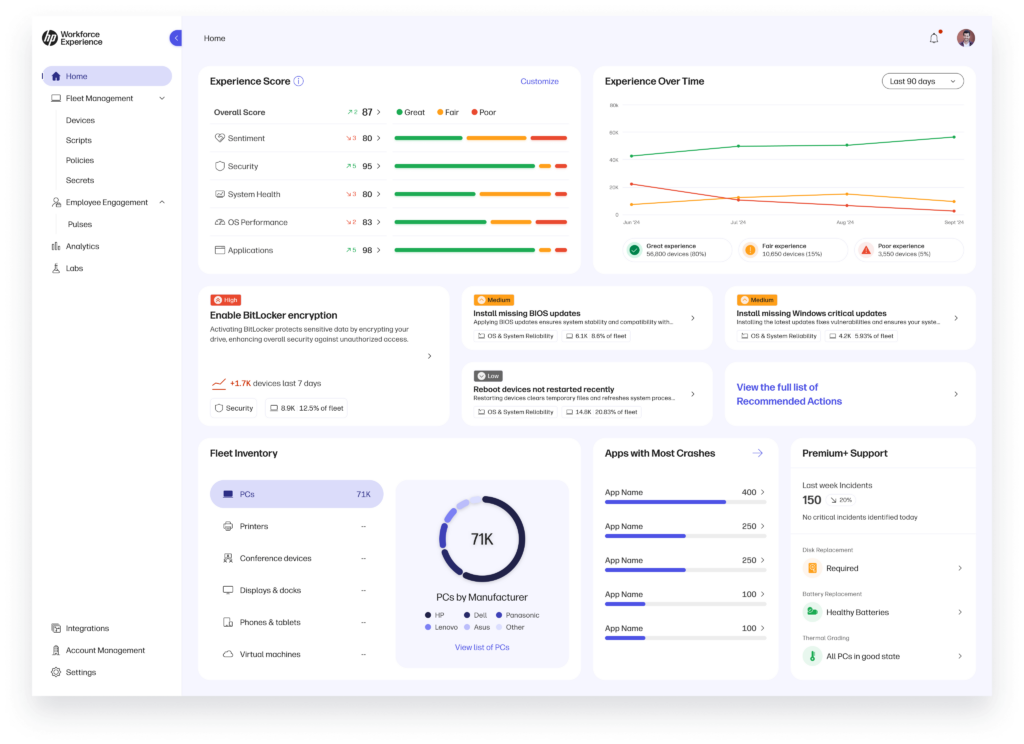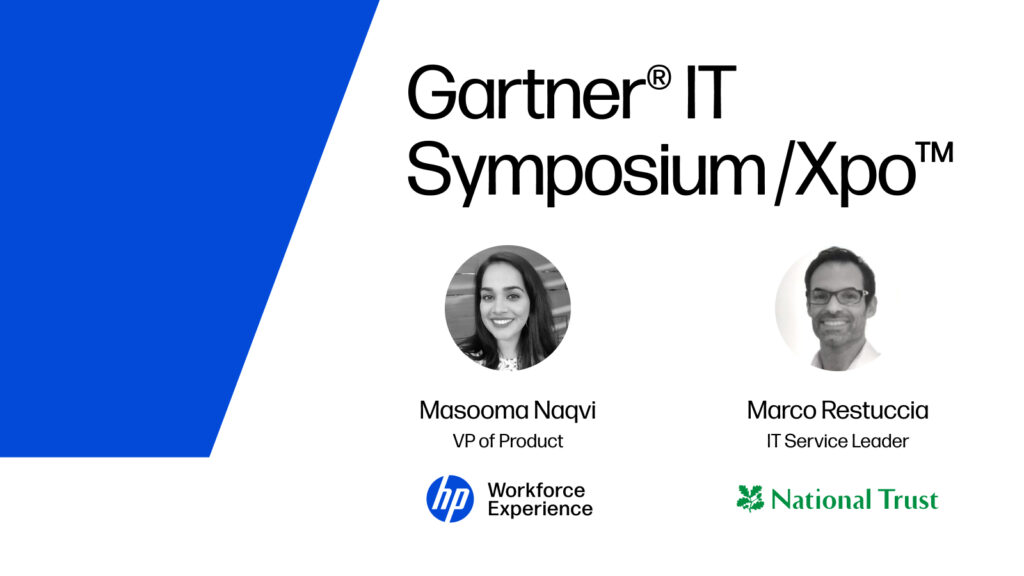What is ITAM? A Guide to Successful IT Asset Management
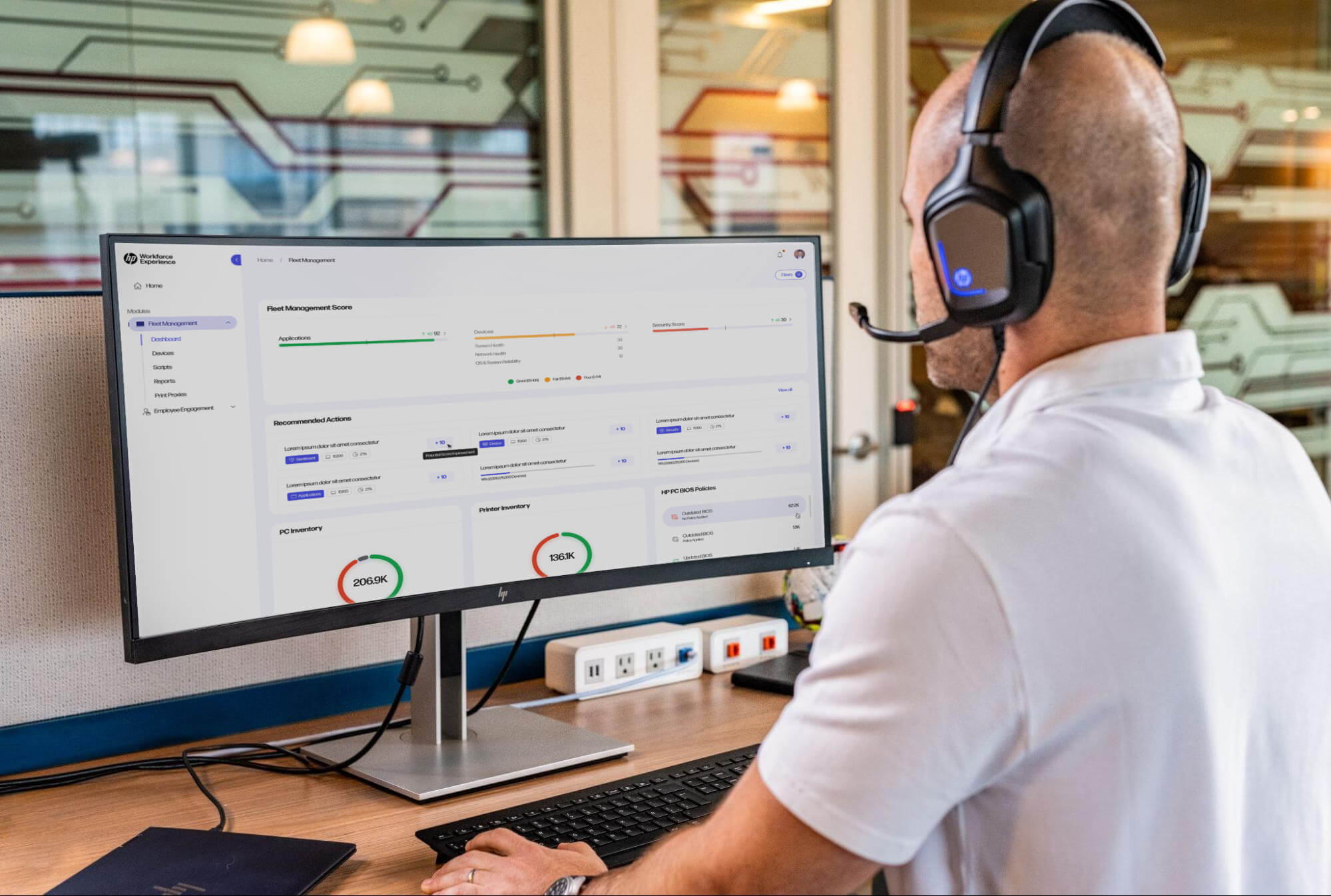
Summary
- IT Asset Management (ITAM) tracks, manages, and optimizes an organization’s assets across the IT lifecycle from procurement to disposal.
- ITAM can help manage inventory, lower costs, enhance asset visibility and control, optimize refresh cycles, and improve security, compliance, and software asset management and licensing.
- With the HP Workforce Experience Platform (WXP), IT Fleet Management combines AI-backed anomaly detection and autonomous remediations to monitor and manage all your devices across their lifecycle.
Introduction
IT assets like software and devices make up about 35% of overall IT spending, yet IT Asset Management (ITAM) might be one of the least understood aspects of any organization. Sure, it involves managing a company’s IT assets throughout the IT lifecycle, but whether you’re a large or small company, optimizing ITAM often requires a data-backed approach to maintaining strong visibility and control over your company’s capital investments.
Today, the challenges are even more complex. Against a backdrop of rising hybrid and remote work, Gartner forecasts worldwide IT spending will continue to grow at a rapid clip and soar to $5 trillion in 2024, up 6.8% from 2023. Projected to fuel this growth will be spending on software (up 12.7% from 2023) and work devices (up 4.6% from 2023), including smartphones, PCs, laptops, printers, collaboration equipment, and more.
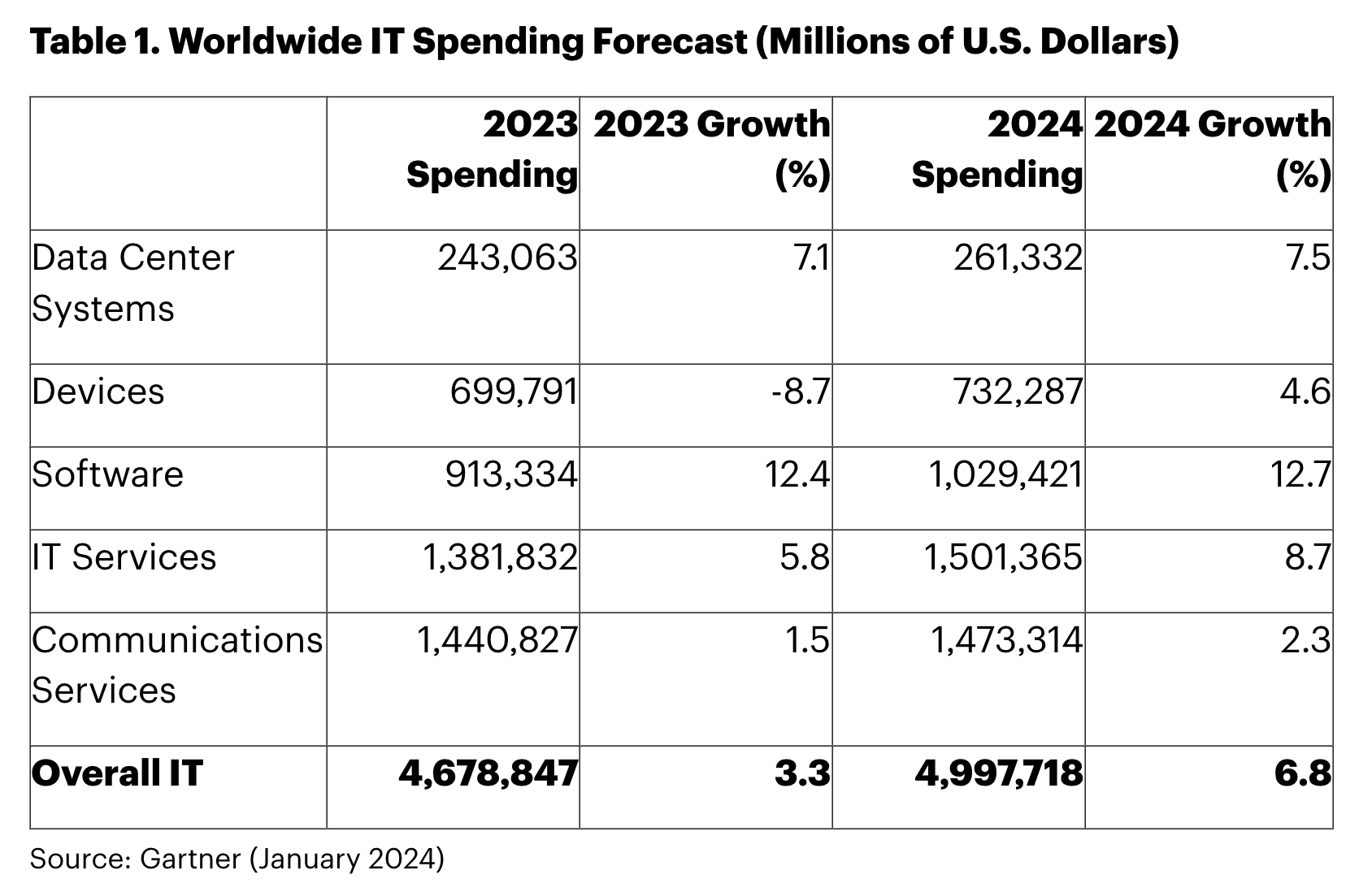
Meanwhile, according to HP’s Work Relationship Index, only 27% of knowledge workers have a healthy relationship with work, with one key factor being the tools and technologies they use. Furthermore, 76% of people in unhealthy work relationships contemplate leaving their current companies.
Download the HP Work Relationship Index
Taking center stage
Now more than ever, business leaders need to take it upon themselves to gain better visibility into their IT environments, get the most out of their capital investments, and ensure employees have the tools they need to do their best work. According to Phara Estime McLachlan, CEO of Nahteava and ITAM expert, today’s CIOs need to be able to answer seven essential questions regarding their IT assets:
- What assets are in place?
- What return are the assets providing to the business?
- How is the company improving the assets’ return?
- How are the asset investments performing?
- How are the asset investments performing relative to the competition?
- Do the assets put the business at risk in any way?
- If so, how is risk managed?
Ahead, we’ll dive into what you need to know about ITAM, including what it is, how it works, best practices, and how to leverage it to enhance your organization’s IT operations. Let’s begin!
What is IT Asset Management (ITAM)?
IT Asset Management (ITAM) is the end-to-end process of tracking, managing, and optimizing an organization’s IT assets so that every asset is used correctly, maintained, upgraded, and eventually disposed of at the end of its lifecycle. The three main components of ITAM include:
- Hardware (physical devices such as PCs, printers, network equipment, collaboration devices, etc.)
- Software (licensed applications and operating systems)
- Digital assets (data, cloud services, etc…)
With WXP, IT Fleet Management is a powerful module that combines AI-backed anomaly detection and autonomous remediation capabilities to monitor and manage all your devices across their lifecycle, including PCs, Macs, printers, collaboration tools, and accessories.
What is the IT lifecycle?
All technology has a limited period of usefulness before it becomes obsolete. Companies must manage and refresh their fleets of devices before they become financial and operational burdens. When an organization invests in technology, the IT lifecycle refers to the stages an IT asset goes through, which includes planning, purchasing, deployment, maintenance, and eventually, replacement, and disposal/recycling.
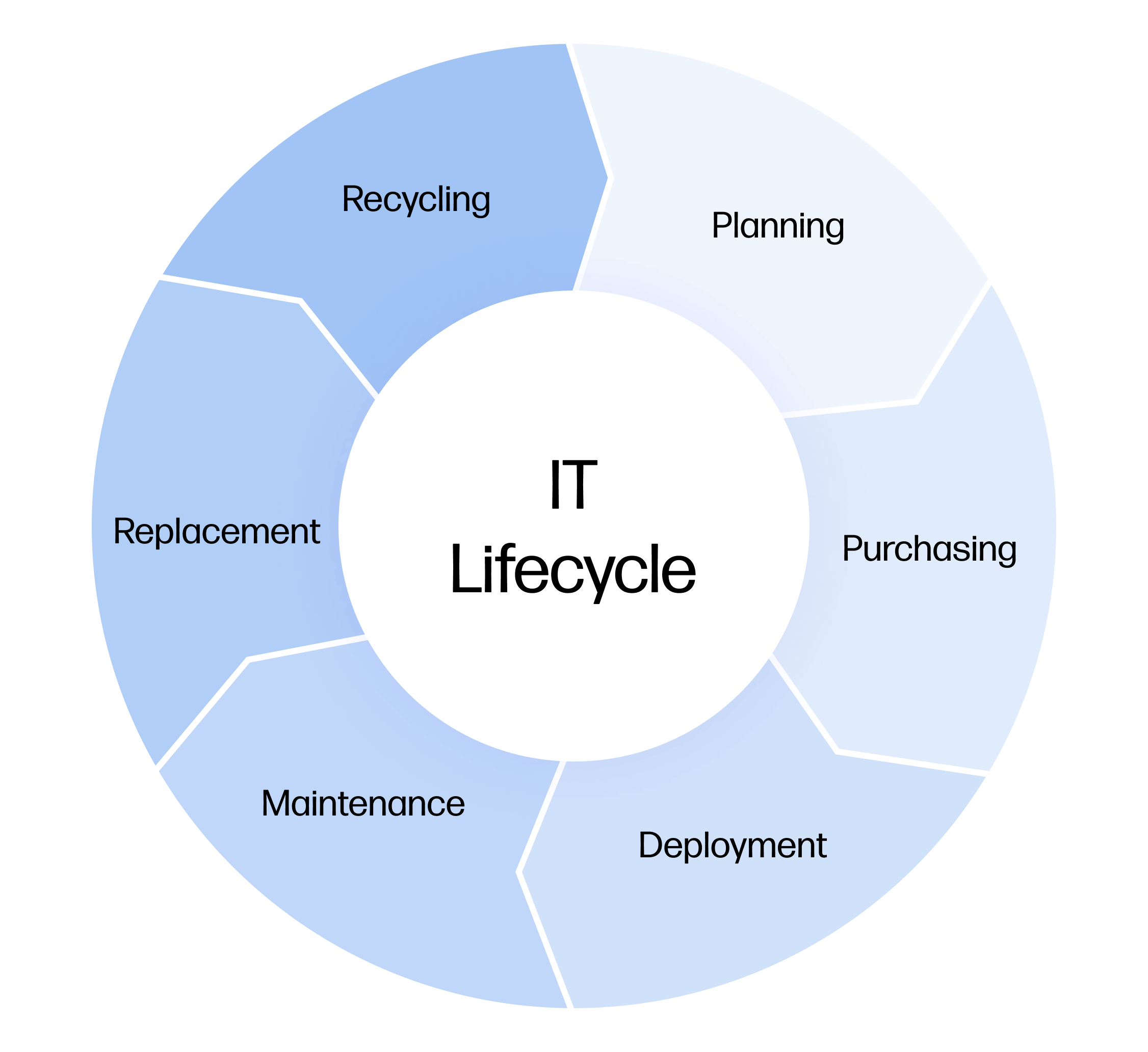
Stages of the IT lifecycle.
7 Key Benefits of ITAM
The benefits of optimizing ITAM can be enormous. IT assets need to be optimized and working correctly to empower employees to do their best work. To avoid employee workflow disruptions, organizations need to identify assets that are no longer useful and replace them before they impact productivity.
That’s why understanding the financial, operational, and contractual relationships of assets is so important for increasing ROI. Accurate inventory leads to better planning and forecasting, which leads to smarter and more informed strategies. ITAM can result in better regulatory compliance, cost savings, improved sustainability, and optimized refresh cycles when done right.
1. Enhanced asset visibility and control
IT teams gain visibility into asset inventory details, hardware or software issues, root causes, usage patterns, and compliance. Ultimately, this improves accountability and transparency and ensures that resources are appropriately managed and utilized.
2. Improved efficiency and productivity
ITAM software helps to streamline and automate manual processes such as asset discovery, asset tracking, updates, and license management. Companies can save time, reduce resource use, eliminate errors, and free up IT staff to focus on more strategic initiatives, boosting overall efficiency and productivity.
3. Higher cost savings
Optimizing ITAM means organizations can better match the supply of devices to the demand from their employees. Additionally, better asset utilization and lifecycle management can reduce maintenance costs, lower IT support expenses, and extend the life of existing assets.
4. Reduction of compliance risks
An ITAM system reduces compliance risks by ensuring all software and hardware meet corporate security policies and standards. ITAM helps identify unapproved or harmful installations, allowing system administrators to quickly isolate vulnerabilities such as unauthorized software, outdated programs, and malicious downloads.
5. More accurate device fleet inventory planning and investments
ITAM provides detailed insights into asset performance and usage. IT leaders can analyze data to forecast future asset needs, secure budgets, and make informed decisions across the IT lifecycle’s planning, purchasing, and deployment phases.
6. Improved software and license management:
While ITAM manages financial, licensing, and contractual aspects of IT assets, a component of ITAM is software asset management (SAM), which manages, controls, and tracks software assets and licenses through their lifecycle. In addition to helping organizations negotiate and manage vendor relationships and contracts, SAM also helps minimize audit and financial risks, enhances cybersecurity by preventing unauthorized software, improves budgeting, and boosts operational efficiency.
7. Improved security
You can’t secure what you can’t see. That’s why ITAM is a critical piece of IT security. According to Deloitte, an ITAM solution can:
- Improve incident response, investigations, and remediation, deliver robust endpoint protection, and detect vulnerabilities.
- Discover a device’s location, configuration, and ownership
- Prioritize critical infrastructure by identifying the most significant assets
- Help with compliance with Sarbanes-Oxley and with standards such as the Payment Controls Industry-Data Security Standard
- Monitor and manage inventory as against the entitlement of hardware and software assets
- Patch IT asset vulnerabilities while serving as a tool for patch management
- Improve helpdesk response by telling staff what is installed and alerting them to errors and other issues.
In Deloitte’s IT Asset Management Global Survey, they found that there is still room for improvement in aligning ITAM and cybersecurity within organizations. 77% of respondents agree that ITAM is a must-have for cybersecurity, but 45% say they’re not making the right investments in ITAM, and 54% say ITAM doesn’t work closely with their security team.
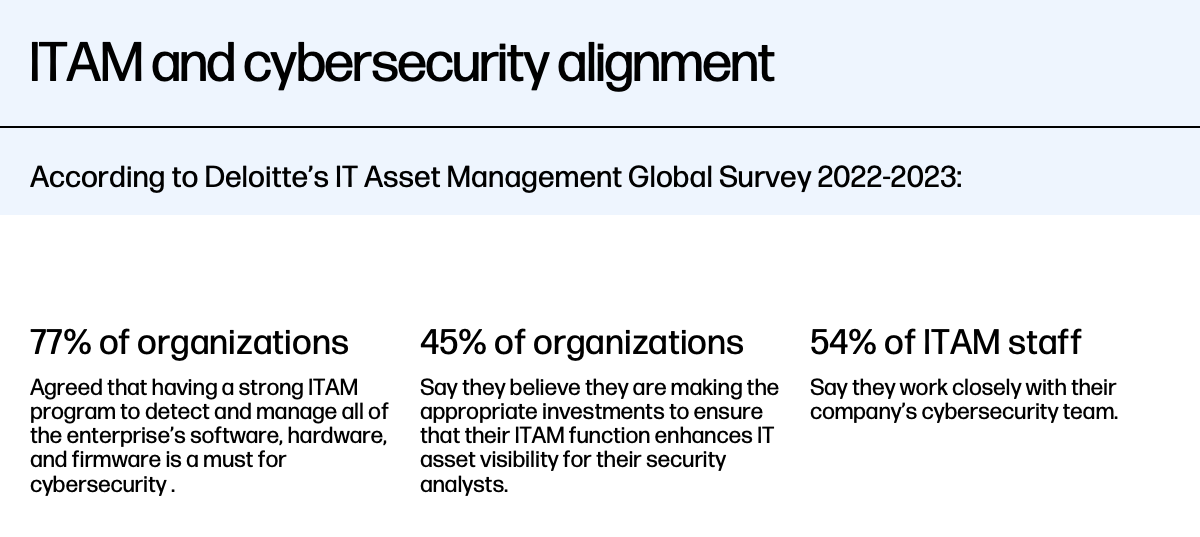
Why is ITAM Important for Organizations Today?
The strongest driver for investing in an ITAM program is cost optimization across assets. However, 83% of companies acknowledge that the lack of IT visibility is a major hurdle to overcome. Meanwhile, only 41% say they have regularly updated tools and equipment for managing IT assets, and just 30% have teams equipped to tackle emerging expectations.
Mismanagement of assets and operations can erode productivity. In a recent study on hybrid work, nearly half (49%) of employees reported losing between one and five hours of productivity per week dealing with IT issues, and 23% reported losing six hours or more. Additionally, Deloitte found that their clients implementing SAM had unrealized cost savings averaging 23% of their annual maintenance spend for software licensing.
Optimizing the IT Asset Management Process
The ITAM process follows the IT lifecycle, including planning, purchasing, deployment, maintenance, replacement, and disposal or recycling of IT assets. For the IT management process to be effective, businesses must establish clear policies and procedures, follow best practices, and follow a continuous improvement model. ITAM expert Phara Estime McLachlan breaks the process down into several major components:
1. Identification of asset requirement:
Determining an organization’s IT asset needs starts with creating a detailed inventory of all IT assets, including details like operating system, asset location, ownership, and configuration details. User requests for hardware and software must be approved to ensure alignment with goals and budgets.
2. Planning:
Planning involves assessing if available IT assets exist in inventory or identifying the need to purchase new ones.
3. Procurement:
Procurement involves ordering IT assets if they are not in inventory. Important considerations include using approved suppliers/vendors and determining terms for installation, deployment, and warranties.
4. Configuration and deployment:
IT teams are responsible for configuring assets, updating the inventory, installing necessary software, and deploying the assets within the environment. This part of the ITAM process ensures that the asset is appropriately integrated and ready for use.
5. Install, move, add, change, disposal (IMACD):
The IMACD (Install, Move, Add, Change, Disposal) process encompasses all daily IT asset activities such as installation, configuration changes, equipment relocation, and decommissioning, all while minimizing disruptions to the business. Its goals include maintaining control and accountability, pre-planning changes, reducing shadow support, and building a database to track maintenance trends and support technical reviews. IMACD also manages the impact of new hires, terminations, and other changes on IT assets.
6. Decommission, disposition, and disposal:
Retiring IT assets involves planning and managing the end-of-life phase for IT assets. This process includes technology refresh cycles, returning leased assets, and retaining or disposing of purchased assets based on their condition.
Must-Have Features for Choosing IT Asset Management Software
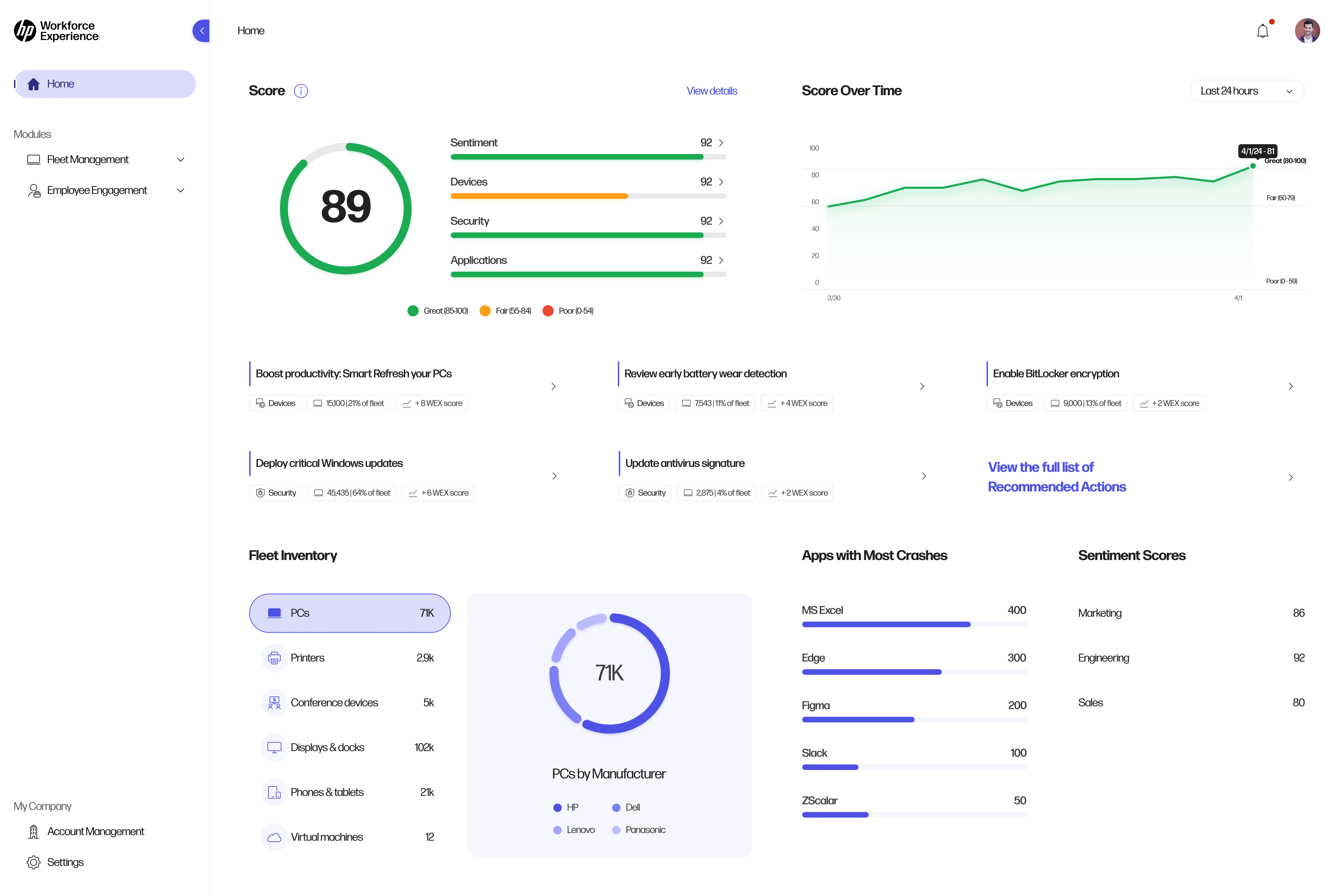
IT Fleet Management with WXP.
Selecting the right ITAM software and complementary ITAM services is crucial for optimizing asset management processes. Here are some must-have features to consider:
Device and OS-agnostic
Many ITAM solutions specialize in PCs, but organizations generally have to manage various devices and endpoints with different operating systems, including PCs, peripherals, printers, accessories, and collaboration equipment. For example, the HP Workforce Experience Platform is a unified ITAM platform for IT management that is device- and OS-agnostic and can help simplify asset tracking and management across a device fleet.
Reporting and analytics
Organizations need powerful software to analyze and learn from large amounts of telemetry data gathered from many sources and provide comprehensive reporting capabilities, preferably from an intuitive “single-pane-of-glass.” IT teams can gain clear insights into fleet health data like app stability, asset utilization, performance, security, and compliance and make data-backed recommendations to solve issues.
Asset discovery and inventory lifecycle management
IT teams need visibility into device timelines to track changes and anomalies over time and to optimize device refreshes across the ITAM lifecycle. When evaluating SaaS providers, companies should look for software that offers \ asset discovery capabilities and supports the entire lifecycle of IT assets, from procurement to disposal, to identify and track all IT assets at every stage.
Integration with other IT and business systems
One crucial consideration is integration with existing IT infrastructure and systems. Companies should choose software that seamlessly integrates with their enterprise systems, such as unified endpoint management, IT service management, and help desk solutions. Integrations can ensure smooth operations in multi-vendor and multi-OS environments.
Real-time data and fast remediation
Companies want insights into events as soon as they happen, without waiting hours or days for critical information. With access to real-time telemetry data gathered from devices, companies can identify emerging issues before they become widespread and immediately deploy remediations to a device or group to resolve end-user experience issues.
Additional considerations
Every organization is different. Companies looking to find the right ITAM solution or specialized ITAM services to suit their individual needs need to evaluate features, pricing, and customer reviews across software vendors and also consider factors such as scalability, vendor support, and implementation complexity.
However, some features and functions are must-haves for ITAM. Prioritizing what’s important can help you choose the right software to simplify and streamline your company’s asset management processes.
IT Fleet Management with the HP Workforce Experience Platform
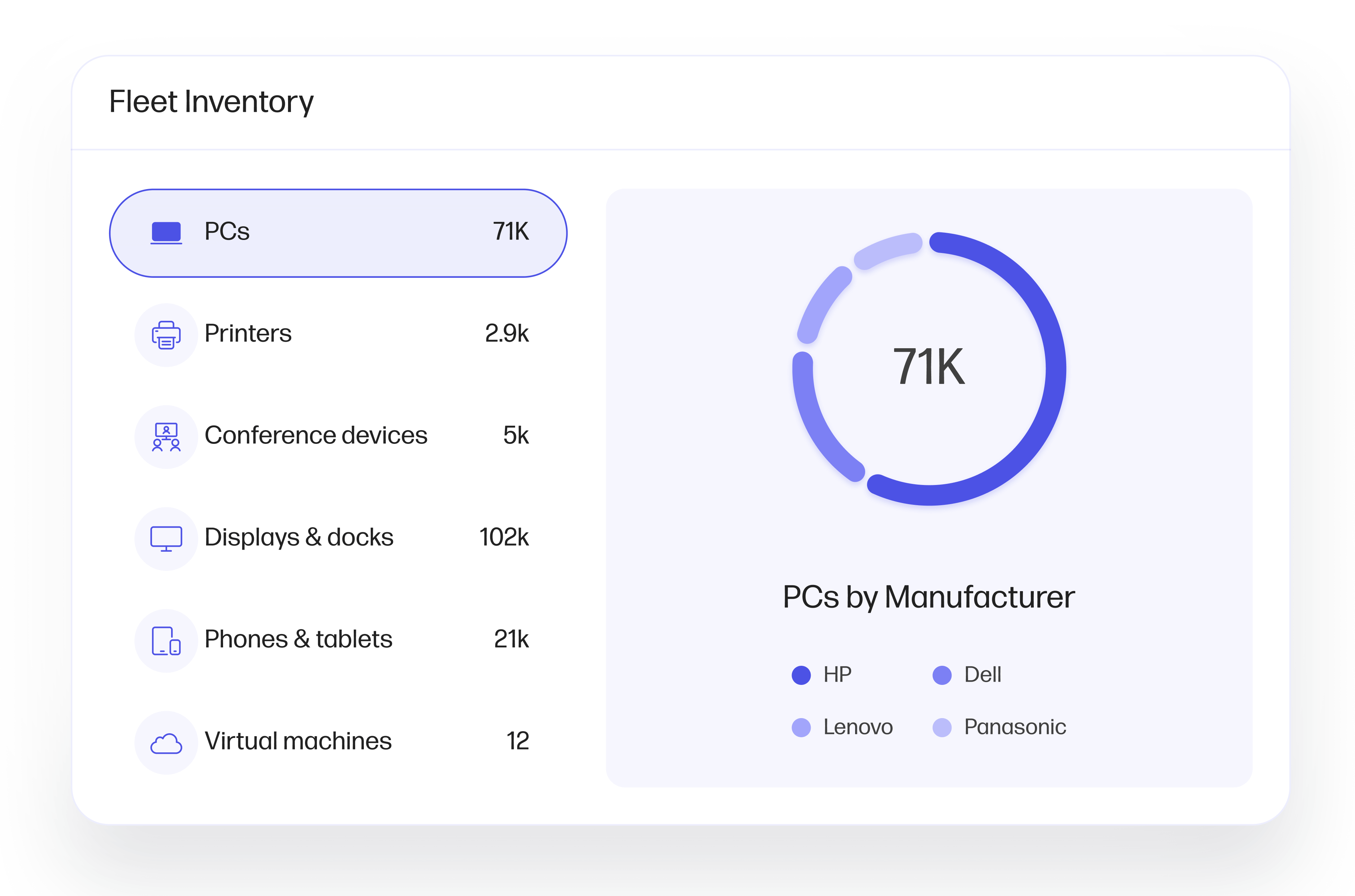
ITAM is indispensable for modern businesses. By implementing a unified ITAM system, companies can enhance their visibility and control over their hardware and software assets, achieve cost savings, and reduce security and compliance risks while enhancing employee engagement and productivity.
WXP is a complete digital employee experience solution that features IT fleet management to streamline and simplify any enterprise ITAM program. It provides unified fleet monitoring, management, and remediation capabilities across PCs, printers, collaboration tools, and accessories to simplify and streamline IT operations. Additionally, companies can leverage features like anomaly detection, dynamic employee personas, smart device refreshes, and real-time data to increase employee productivity and reduce costs.
Want to learn more about how WXP can optimize your IT asset utilization and align your investments with your business goals? We’d love to speak with you! Contact us today to begin harnessing the power of ITAM for your organization.
FAQ
What is the meaning of ITAM?
ITAM, or IT Asset Management, refers to managing an organization’s IT assets throughout their ITAM lifecycle, from acquisition to retirement.
What does an ITAM analyst do?
An ITAM analyst analyzes and optimizes an organization’s IT asset management processes and strategies. An ITAM specialist oversees the implementation and maintenance of ITAM practices, ensuring efficient asset management.
Is ITAM the same as configuration management?
No, ITAM and configuration management are related but distinct disciplines. ITAM focuses on managing IT assets, while configuration management specifically deals with managing the configurations of those assets.
What’s the difference between ITAM and ITSM?
IT Service Management (ITSM) focuses on managing the delivery of IT services to users. ITAM revolves around tracking and managing IT assets throughout their lifecycle. These services complement each other: ITSM relies on accurate asset data from ITAM for service delivery. For example, ITSM utilizes ITAM data to prioritize service requests and ensure timely resolution.
What is ISO 19770?
ISO, the International Organization for Standardization, provides a comprehensive set of standards called ISO/IEC 19770. This international standard specifies requirements for IT Asset Management (ITAM) processes and systems and comprises five parts that outline best practices and guidelines.
- ISO/IEC 19770-1:2017 outlines a framework for ITAM processes to ensure organizations meet software management governance standards.
- ISO/IEC 19770-2:2015 defines a standard for creating software identification (SWID) tags, which are XML files containing details about installed software for easier discovery and management.
- ISO /IEC 19770-3:2016 provides software entitlement standards focused on capturing and defining the information necessary to describe how software may be used to better enable companies to understand the assets they’ve already purchased.
- ISO/IEC 19770-4:2017 establishes specifications for an information structure to contain Resource Utilization Measurement information to facilitate ITAM.
ISO/IEC 19770-5:2015 serves as a primer for the entire IT asset management standard family, introducing key concepts, terminology, and the foundation of software asset management.
HP Workforce Experience Platform is a comprehensive and modular digital employee experience solution that enables organizations to resolve IT issues before they arise, protect against cyber threats, and personalize IT for every employee’s needs.
Subscribe to the HP Workforce Experience Blog or schedule a consultation with our team to begin optimizing your IT capabilities today.
From the blog
The latest industry news, interviews, technologies, and resources.
Frequently asked questions
Here's everything you need to know about WXP.
- What is the HP Workforce Experience Platform (WXP)?
- How does WXP work?
- Can WXP be customized to fit specific business needs?
- How is WXP modular?
- Is WXP compatible with different vendors and operating systems?
- How does WXP integrate with other IT tools to provide a more comprehensive solution?
- What is a Workforce Experience score?
- How is AI used within WXP?
- How can I buy WXP and find out about new releases?


